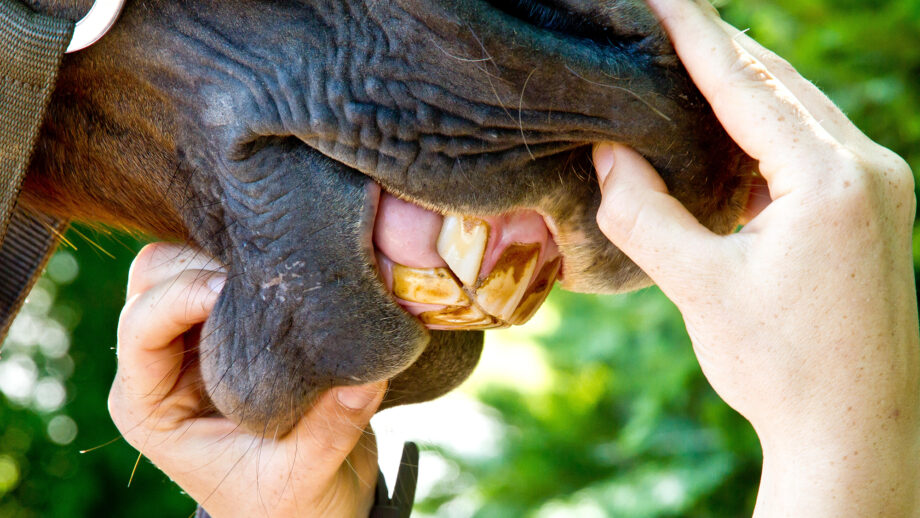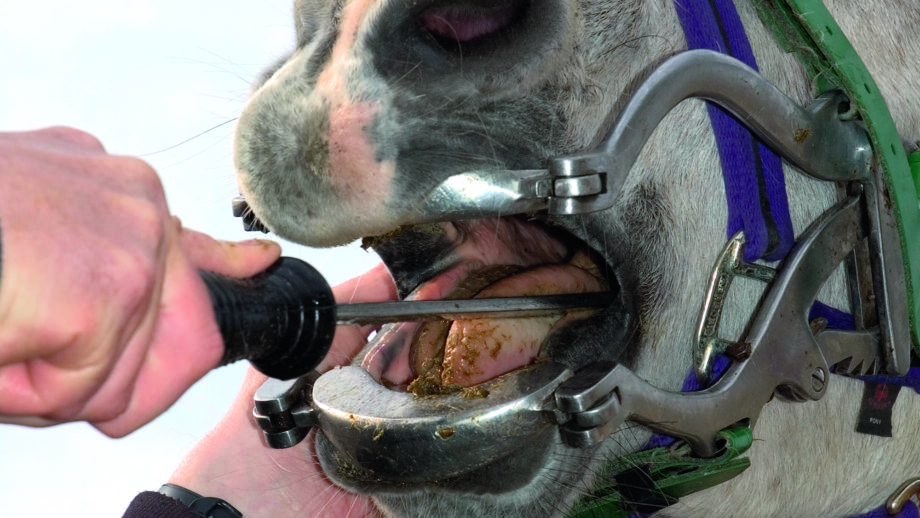Dental check-ups should be a regular feature in your horse’s basic health care routine. Andrea Oakes looks at problems that can arise in the mouth
When it comes to equine dentistry, the days of a quick “once over” with a rusty rasp are long gone. Regular and detailed dental check-ups are now the norm for the well-cared for horse, allowing skilled practitioners to detect developing issues before they become real problems.
Since a comfortable mouth is a mainstay of good condition, behaviour and performance, it makes sense to start this routine care in a horse’s early years. When is it best to begin?
“Up until the age of five, a horse’s adult teeth are erupting and shedding their ‘caps’ – the remnants of the deciduous, or baby, teeth,” says Dr Kieran Rowley, an RCVS advanced veterinary practitioner in equine dentistry.
“We would generally recommend a first examination at around two to three years of age, provided that specific issues have not already become apparent.
“A check-up every six months is a good idea with the young horse, so that we can monitor the development of the mouth,” he adds. “We can also deal with any troublesome wolf teeth that may interfere with bitting and require extraction.”
Ideally, routine care will then be ongoing. A preventative approach is a must, explains Kieran, since horses can be surprisingly stoical when it comes to tooth problems.
“As a prey animal, a horse tends to hide pain – so an issue is usually quite advanced once outward signs become apparent to his owner,” he says. “For the adult horse we advise an examination every year, as an absolute minimum, and in some cases more often. This comprises an extra-oral exam, to check facial symmetry and the movement of the jaw and the temporomandibular joints that connect it to the skull, along with an intra-oral examination, inside the mouth, frequently using a gag, a bright head torch, mirrors and small instruments called picks.
“The vet or equine dental technician will be looking for periodontal [gum] disease and tooth problems including holes, gaps, fractures and misalignments, known as malocclusions,” says Kieran, who adds that observations should be noted and records maintained. “It may be necessary to rasp any sharp points and edges. Other issues that cannot be dealt with at the time can be booked in, while more complex problems may be referred to an equine veterinary dental specialist.”
The anatomy of the equine jaw
A horse’s routine requirements will be influenced by his lifestyle, age and dental history.
“Different feedstuffs require different amounts of chewing,” says Kieran, explaining that the anatomy of the equine jaw and the lateral chewing motion naturally create sharpened points. “In theory, a largely grass kept horse will develop sharp points at a slower rate than a horse eating a lot of concentrates. Other factors such as breed and mouth conformation do come into play, however, so more frequent examinations may be necessary.
“Horses doing a lot of collected work with more rein contact, especially in dressage, can also benefit from treatment every six months,” he adds, explaining that “mouthing” or fussiness with the bit, often caused by sharp points pressing on the tongue or inner cheeks, can lead to a deterioration in performance and loss of marks. “Other cases requiring twice-yearly examination include horses who’ve had a molar removed, to prevent overgrowth of the opposite tooth into the empty space, and older horses approaching their twenties and beyond.”
Despite the best care, problems can still arise – especially in the ageing mouth.
“From late teens, abnormal gaps called diastema can form between the horse’s teeth, resulting in painful periodontal disease,” says Kieran. “It’s important to be vigilant with a horse of any age, however, for behaviour that may signal tooth pain.
“Signs range from resisting the bit or contact to becoming unusually head shy,” he adds. “The horse may tilt his head or display abnormal jaw movement when eating, or struggle to bite harder foods, such as carrots. Look out for packing of food in the cheeks, like hamster pouches, facial swelling, bad breath, nasal discharge, usually from a single nostril, or ‘quidding’, where the horse drops unchewed food as he eats. Signs may be so subtle, however, that you don’t notice until the horse loses weight.
“Any of these issues warrants a check-up, but certain situations require emergency treatment. These include a recently fractured incisor tooth, which we can often save with a simple technique called pulp capping, or a badly swollen face that might indicate a tooth root abscess.”
Modern treatment techniques include swift and effective extraction methods, fillings and endodontics – the term for root canal work. Yet perhaps the biggest advance in equine health, believes Kieran, has been a greater understanding of what can go wrong and the ability to identify these issues during routine examination.
“Correct and regular care can prevent long-term problems or loss of teeth, potentially extending a horse’s active years and easing the ageing process,” he says. “It’s a huge advantage to pick conditions up in the early stages.”
Avoiding erosion
Thankfully, there’s no requirement for twice-daily brushing of a horse’s teeth. Where food tends to become stuck between gappy incisors, however, Kieran suggests removing it gently two or three times a week with a toothbrush or a soft pick.
“Another measure to prevent decay is to be selective with the treats,” Kieran adds. “Something natural is best. Avoid mints that are sugary or chewy, as these can stick to the teeth and potentially cause erosion.”
Who’s qualified?
How can you make sure your horse is in safe hands? Neil Townsend, an RCVS specialist in equine dentistry, answers some frequently asked questions…
Who should I entrust with caring for my horse’s teeth?
“Either a vet or a suitably qualified equine dental technician (EDT). These are the only people sufficiently trained and legally allowed to diagnose and treat equine teeth, and both groups must hold indemnity insurance and undergo regular professional development training.
“All equine vets are highly trained in dental care and are qualified to carry out any procedure in a horse’s mouth, but some have a special interest in dentistry and go on to pass EDT exams or to become advanced practitioners or specialists. Qualified EDTs have undergone training and examination to become a member of the British Association of Equine Dental Technicians (BAEDT) or the Worldwide Association of Equine Dentistry (WWAED).”
For basic work, is it worth considering an unqualified EDT – or someone sometimes incorrectly termed an equine dentist?
“By law, anyone can use a hand rasp to file sharp points in a horse’s mouth. Yet a so-called ‘equine dentist’ has had no regulated training and has no recognised qualifications, while an unqualified EDT has not met the rigorous BAEDT or WWAED standards. Neither group can use motorised equipment or diagnose or treat issues in a horse’s mouth, and in neither case can you be confident that your horse is receiving quality care with appropriate protection should anything go wrong.”
What about more complex treatment?
“Only a vet can diagnose issues, administer sedation if required, or treat problems such as fractured teeth or diastemata. A qualified EDT will be keen to work with your horse’s vet, carrying out routine examination and corrective rasping but referring any abnormalities for further veterinary evaluation and treatment.”
Ref Horse & Hound; 12 November 2020
You may also be interested in:

Would you spot if your horse had a tooth infection? Find out how and what treatment is available

Subscribe to Horse & Hound magazine today – and enjoy unlimited website access all year round
